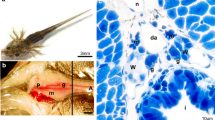Abstract
Initial gonadal development was studied in 30- to 40-day-old bovine embryos. The results were interpreted in conjunction with findings on pro- and mesonephric organization in larval forms of Ichthyophis kohtaoensis (Gymnophiona, Amphibia). In bovine embryos vestigial nephrostomial tubules are the immediate precursors of the blastemas for adrenocortical, rete, gonadal and Müllerian infundibular development. From the study of Ichthyophis it can be concluded that the vestigial nephrostomial tubules seen in the bovine embryo are pronephric and not mesonephric in nature. As a consequence, the indifferent mammalian gonad is defined as a modified homologue of the pronephros situated in the zone of pro-/mesonephric overlapping. Such an overlapping of the two kidney generations in the fully developed state is clearly seen in Ichthyophis. Overlapping of the mesonephros with the modified pronephros (gonad) is necessary to allow intercalation of mesonephric tubules (efferent ductules in mammals) into the male seminal excurrent duct system.
Similar content being viewed by others
Author information
Authors and Affiliations
Additional information
Accepted: 22 October 1999
Rights and permissions
About this article
Cite this article
Wrobel, KH., Süß, F. The significance of rudimentary nephrostomial tubules for the origin of the vertebrate gonad. Anat Embryol 201, 273–290 (2000). https://doi.org/10.1007/s004290050317
Issue Date:
DOI: https://doi.org/10.1007/s004290050317




